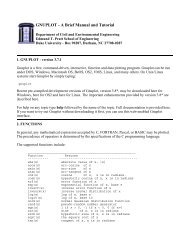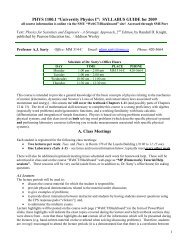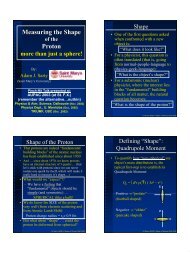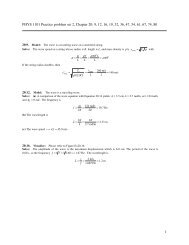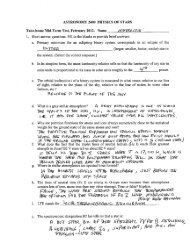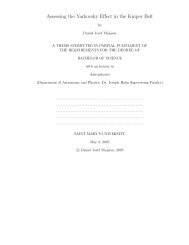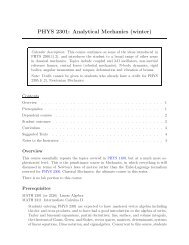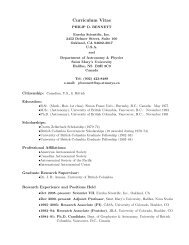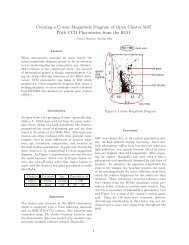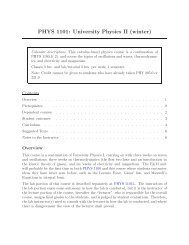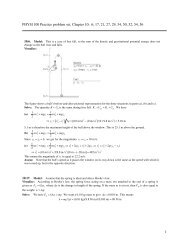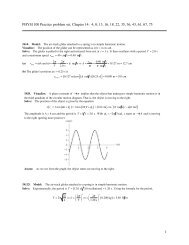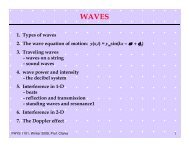1 PHYS 1101 Practice problem set 11, Chapter 32: 4, 7, 18, 38, 41 ...
1 PHYS 1101 Practice problem set 11, Chapter 32: 4, 7, 18, 38, 41 ...
1 PHYS 1101 Practice problem set 11, Chapter 32: 4, 7, 18, 38, 41 ...
- No tags were found...
You also want an ePaper? Increase the reach of your titles
YUMPU automatically turns print PDFs into web optimized ePapers that Google loves.
F on 2F on 3= F 1 on 3+ F 2 on 3+ F 3 on 2= ( −5.0 × 10 −4 ˆ j ) N + ( +5.0 ×10 −4 ˆ j ) N = 0 N( ) N + ( −5.0 × 10 −4 ˆ j ) N = −2.5 × 10 −4 ˆ= F 1 on 2= 2.5 ×10 −4 ˆ j( )j N = 2.5 ×10 −4 N, down<strong>32</strong>.<strong>41</strong>. Solve: From Equation <strong>32</strong>.28, the torque on the loop exerted by the magnetic field isτ = µ × B ⇒ τ = µB sinθ = IABsinθ = ( 0.500 A )( 0.05 m × 0.05 m )( 1.2 T )sin30° = 7.5 ×10 −4 N m<strong>32</strong>.46. Model: The magnetic field is the superposition of the magnetic fields of three wire segments.Visualize: Please refer to Figure P<strong>32</strong>.46Solve: The magnetic field of the horizontal wire, with current I, encircles the wire. Because the dot is on the axis of thewire, the input current creates no magnetic field at this point. The current divides at the junction, with I/2 traveling upwardand I/2 traveling downward. The right-hand rule tells us that the upward current creates a field at the dot that is into thepage; the downward current creates a field that is out of the page. Although we could calculate the strength of each field,the symmetry of the situation (the dot is the same distance and direction from the base of each wire) tells us that the fieldsof the upward and downward current must have the same strength. Since they are in opposite directions, their sum is 0 .Altogether, then, the field at the dot is B = 0 T.<strong>32</strong>.48. Model: The magnetic field is that of two long wires that carry current.Visualize:Solve: (a) For x > +2 cm and for x < −2 cm, the magnetic fields due to the currents in the two wires add. The point wherethe two magnetic fields cancel lies on the x-axis in between the two wires. Let that point be a distance x away from theorigin. Because the magnetic field of a long wire is B = µ 0 I 2πr , we haveµ 02π( 5.0 A )( 0.02 m + x) = µ 0( 3.0 A )⇒ 5(0.02 m – x) = 3(0.02 m + x) ⇒ x = 0.005 m = 0.50 cm2π ( 0.02 m − x) (b) The magnetic fields due to the currents in the two wires add in the region −2.0 cm < x < 2.0 cm. For x 2.0 m, the two fields will cancel at a point on the x-axis. Let that point be a distance x away fromthe origin, soµ 05.0 A2π x + 0.02 m = µ 3.0 A0⇒ 5(x − 0.02 m) = 3(x + 0.02 m) ⇒ x = 8.0 cm2π x − 0.02 m<strong>32</strong>.52. Model: Use the Biot-Savart law for a current carrying segment.Visualize: Please refer to Figure P<strong>32</strong>.52. The distance from P to the inner arc is r 1 and the distance from P to the outer arcis r 2 .Solve: As given in Equation <strong>32</strong>.6, the Biot-Savart law for a current carrying small segment Δs is2
B = µ IΔs × r ˆ04π r 2For the linear segments of the loop, B Δs = 0 T because Δs × r ˆ = 0 . Consider a segment Δs on length on the inner arc.Because Δs is perpendicular to the r ˆ vector, we haveB = µ IΔs0= µ Ir0 1Δθ= µ IΔθ0⇒ B2 2 arc 1 =4π r 14π r 14π r 1π 2∫−π 2µ 0Id θ4πr 1= µ 0 I4πr 1π = µ 0 I4r 1A similar expression applies for B arc 2. The right-hand rule indicates an out-of-page direction for B arc 2 and an into-pagedirection for B arc 1 . Thus,The field strength isB =⎛ µ I ⎞ ⎛0⎜ , into page ⎟ +µ I⎞ ⎡0⎜ , out of page ⎟ =µ I ⎛ 10− 1 ⎞ ⎤⎢ ⎜ ⎟ , into page ⎥⎝ 4r 1⎠ ⎝ 4r 2⎠ ⎣ ⎢ 4 ⎝ r 1r 2⎠ ⎦ ⎥B =Thus B = (7.85 × 10 –5 T, into page).( 4π × 10 −7 T m / A) ( 5.0 A)4⎛ 1.01 m − 1 ⎞⎜⎟ = 7.85 × 10 −5 T⎝ .02 m ⎠<strong>32</strong>.59. Model: The magnetic field is that of a current in the wire.Visualize: Please refer to Figure P<strong>32</strong>.59.Solve: As given in Equation <strong>32</strong>.6 for a current carrying small segment Δs , the Biot-Savart law isB = µ IΔs × r ˆ04π r 2For the straight sections, Δs × r ˆ = 0 because both Δs and r ˆ point along the same line. That is not the case with thecurved section over which Δs and r are perpendicular. Thus,B = µ IΔs0= µ IRdθ0= µ Id θ 04π r 2 4π R 2 4πRwhere we used Δs = RΔθ ≈ Rdθ for the small arc length Δs. Integrating to obtain the total magnetic field at the center ofthe semicircle,B =π 2∫−π 2µ 0Idθ4πR= µ I 04πR π = µ I 04R<strong>32</strong>.63. Model: Energy is conserved as the electron moves between the two electrodes. Assume the electron starts fromrest. Once in the magnetic field, the electron moves along a circular arc.Visualize:The electron is deflected by 10° after moving along a circular arc of angular width 10°.Solve: Energy is conserved as the electron moves from the 0 V electrode to the 10,000 V electrode. The potential energyis U = qV with q = –e, so3
v =K f + U f = K i + U i ⇒ 1 2 mv 2 − eV = 0 + 02eVm = 2(1.60 × 10 −19 C)(10, 000 V)9.<strong>11</strong>× 10 −31 kg= 5.93 ×10 7 m/sThe radius of cyclotron motion in a magnetic field is r = mv/eB. From the figure we see that the radius of the circular arc isr = (2.0 cm)/sin10°. ThusB = mver = (9.<strong>11</strong> ×10 −31 kg)(5.93 ×10 7 m/s)(1.60 × 10 −19 C)(0.02 m) / sin10° = 2.9 ×10 −3 T<strong>32</strong>.71. Model: A magnetic field exerts a magnetic force on a length of current carrying wire. We ignore gravitationaleffects, and focus on the B effects.Visualize: Please refer to Figure P<strong>32</strong>.71. The figure shows a wire in a magnetic field that is directed out of the page. Themagnetic force on the wire is therefore to the right and will stretch the springs.Solve: In static equilibrium, the sum of the forces on the wire is zero:F B + F sp 1 + F sp 2 = 0 N ⇒ ILB + (−kΔx) + (−kΔx) ⇒ I = 2kΔxLB= 2( 10 N / m)( 0.01 m)= 2.0 A( 0.20 m )( 0.5 T)<strong>32</strong>.80. Model: The loop will not rotate about the axle if the torque due to the magnetic force on the loop balances thetorque of the weight.Visualize: Please refer to Figure CP<strong>32</strong>.80.Solve: The rotational equilibrium condition Σ τ net = 0 N m is about the axle and means that the torque from the weight isequal and opposite to the torque from the magnetic force. We have( 50 × 10 −3 kg)g( 0.025 m ) = µBsin90° = ( NIA )B( )( 9.8 m / s ) 20.025 m⇒ B = 50 × 10 −3 kg10( )( )( 2.0 A )( 0.05 m )( 0.10 m )= 0.123 TAssess: The current in the loop must be clockwise for the two torques to be equal.4



